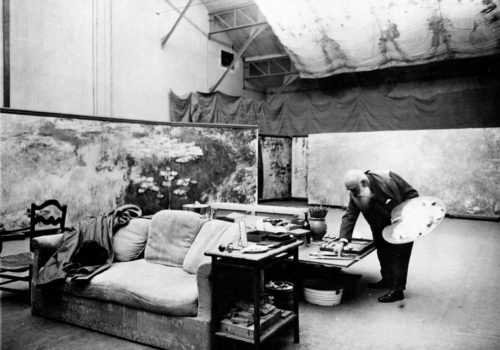In the studio, natural, is the height of artifice ! (Man Ray)
Taking an intimate look at the creative act has always exerted fascination; it also became the object of photographers’ obsession which is being recaptured at the Petit Palais with an epic exhibition of 431 works from three major collections of the City of Paris: those of Roger-Viollet, the Musée Carnavalet, and Petit Palais.
What does it mean to watch an artist work? Which part belongs to sublime reality? How does the fetishization of the artist’s body supersede the quest for the decisive moment? These are just some of the questions raised by this original panorama of epochs and media (painters, sculptors, and photographers). From the beginning of the exhibition the contemporary artists Gautier Deblond and Catherine Leutenegger are presented as worthy heirs to Edmond Bérard, active during the Second Empire. Does it mean that the issues raised by Alexandre Cabanel, in his Parisian studio in the 1880s, or by Ron Mueck’s clinical studies, or by Anish Kapoor or Ellsworth Kelly are all the same? The artist as the grand manipulator of the image seems to be a constant theme if one looks at Jeff Koons’ strategies in Vanity Fair, which are not far removed from Ingres’ process captured by Nadar in “The Man Who Never Laughed” (1856–1858), or Disdéri’s postcards and Foujita’s work, all coveted by collectors. While the techniques change (starting with the daguerreotype), the staging of the self among eye-catching clutter is a staple motif, like in Francis Bacon and his disorderly studio encapsulated in a Charles Matton enclosure. Whether nineteenth-century bourgeois décors or twentieth-century bohemian settings covered with props, these studio interiors belong to a collective imagination relayed by photography and documentary film. From the early stereoscopes to veritable story-boards, some artists become experts in the genre, such as the photographer Lucien Hervé anointed by Le Corbusier, or Hélène Adant who tried to unravel the “mystery of Picasso.” During her stay in Vence Picasso was having fun without ever allowing a glimpse into the origins of his work; Brassaï tried, too. The life of the ogre in his studios, his performances for his children, his dance steps, his friends, his lovers, the whole world passes through the place according to a set ritual. The image of the artist is truly embodied when he is photographed by his closest friends.
Other aspects of this story of the life of artists’ studios, such as the question of the model who often conceals erotic desires, or friendship among the artists at work and the photographer, such the one uniting Gérard Rondeau and Reyberolle, which lasted until the painter’s death; or the friendship between Jesse Fernandez and Marcel Duchamp in the 1950s. Some artists even become photographers themselves, like Brancusi (initiated by Man Ray in Montparnasse) or Bourdelle, both going beyond strictly documentary photography.
But there comes a moment when photography takes revenge when it portrays the artist by picturing the empty studio, starting with traces that open up onto more conceptual approaches. For example Joel-Peter Witkin and his sublime reinterpretation of the classics, starting with Courbet or Rubens; or Illés Sarkantyu who created a colored grid with the covers of folders from Lucien Hervé’s archives; or Joel Meyerowitz and his fresco of personal objects from Cézanne’s studio. Tracking ghosts, making the absent speak, sketching a mindscape in order to explore the medium and its limits.
The question of performance in the studio is raised through Bruce Nauman and his everyday gestures repeated until they lose meaning. An implication of the body at the core of the very process of creation can also be found in other artists, such as Helena Almeida, who is unfortunately absent from this panorama, a fact deplored by the three curators: Delphine Desveaux, Susana Gállego Cuesta, and Françoise Reynaud.
We commend them for their effort in carrying out a project which, while it is not exhaustive, is innovative in its plurality. It’s a story of an illusion where everyone gives what they want to give at a given moment. It undermines the appearances in order to once again foil our viewer’s reflexes.
EXHIBITION
In the studio: the artist photographed from Ingres to Jeff Koons
Curators : Delphine Desveaux, Director of Collections Roger-Viollet, Susana Gállego Cuesta, curator photo collection of Petit Palais and Françoise Reynaud, curator photo collection of musée Carnavalet.
From April 5th to July 17th, 2016
Petit Palais
Avenue Winston Churchill
75008 Paris
France
Tuesday – Sunday 10am – 6pm (Friday till 9pm)
http://www.petitpalais.paris.fr
danslatelier.paris.fr
BOOK
In the studio: the artist photographed from Ingres to Jeff Koons
304 pages, 24 x 30 cm
300 illustrations
Editions Paris Musées
49,90 euros
















